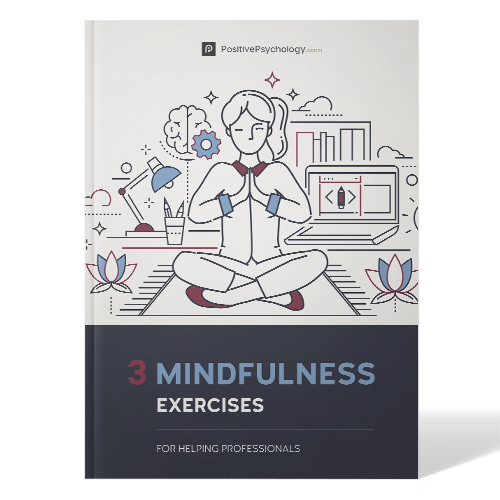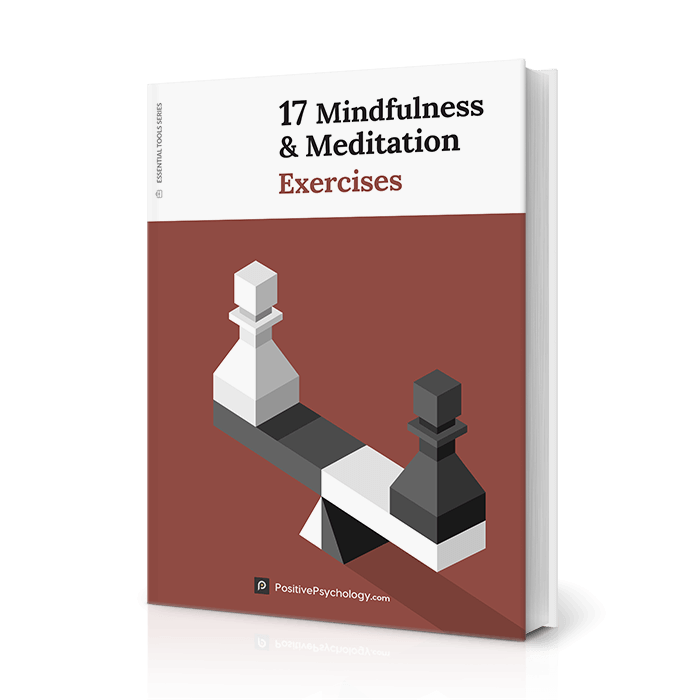Measuring Mindfulness: 11 Assessments, Scales & Surveys
 Mindfulness has been a popular topic at PositivePsychology.com, with frequent pieces on what mindfulness is, how it has been incorporated into therapy, and ways to practice mindfulness for adults, children, and teens.
Mindfulness has been a popular topic at PositivePsychology.com, with frequent pieces on what mindfulness is, how it has been incorporated into therapy, and ways to practice mindfulness for adults, children, and teens.
For some people, it can take a lot of time and effort to understand what mindfulness is and how to practice it effectively.
The concept of mindfulness, of being fully aware and present in the moment but without any value judgments, worrying, or rumination, can be a tough one to grasp.
I apologize in advance to these people, because the topic of this writing excursion may be even more difficult to wrap your head around: measuring mindfulness.
If you’re anything like me, you’re probably thinking: “How in the world do you measure mindfulness?”
It seems like such an ephemeral concept that the idea of trying to take a ruler or a scale to it would be inherently futile. How do you measure the extent to which you are aware of your own thoughts and feelings?
This question posed a challenge for researchers in more ways than one, but a few intrepid souls dared to face the challenge head-on. Consequently, we have some idea of how to go about measuring the presence of mind.
Before you read on, we thought you might like to download our three Mindfulness Exercises for free. These science-based, comprehensive exercises will not only help you cultivate a sense of inner peace throughout your daily life but will also give you the tools to enhance the mindfulness of your clients, students or employees.
This Article Contains:
- First Challenge: State vs. Trait Mindfulness
- Unique Challenges in Measuring Mindfulness
- Wheel of Awareness
- MAAS: The Mindful Attention Awareness Scale
- Five-Facet Mindfulness Questionnaire
- Cognitive and Affective Mindfulness Scale-Revised
- Freiburg Mindfulness Inventory
- Langer Mindfulness Scale
- Solloway Mindfulness Survey
- Kentucky Inventory of Mindfulness Skills
- Automatic Thoughts Questionnaire
- How to Measure Present Moment Awareness
- A Take-Home Message
- References
First Challenge: State vs. Trait Mindfulness
The state of mindfulness measures may be considered as an art that is still in its infancy, partly due to the problem of state vs. trait mindfulness (Hill & Labbé, 2014). Without getting too lost in the weeds, the general idea of the state vs. trait problem is that mindfulness can be considered both a state and a trait (Medvedev, Krägeloh, Narayanan, & Siegert, 2017).
State
A state refers to a fluid and short-term mindset or frame of reference that we can quickly move in and out of, sometimes by force of will. It is a flexible condition that influences how you perceive the world around you. Examples of other states include feeling hopeful, being interested or curious, and feeling certain about something in your life.
Traits
Traits are more permanent facets of personality, characteristics that are difficult to change and likely have some basis in genetics. A trait is often an integral part of what makes you who you are. For instance, psychological traits include extraversion, self-esteem, perfectionism, and impulsivity.
While there are some forms of therapy or behavior modification that can affect traits, they generally do not change without concerted effort.
State Mindfulness
Regarding mindfulness, state mindfulness refers to a temporary condition in which an individual is aware of their thoughts and feelings and able to stay present when distractions arise.
Trait Mindfulness
Trait mindfulness is the more permanent ability to enter a mindful perspective at will, in which an individual recognizes what they are thinking and feeling, accepts them without judgment, and keeps the focus on being present.
Unique Challenges in Measuring Mindfulness

State Measurement Challenges
When measuring state mindfulness, the challenge originates from the fact that measurement necessarily occurs after the experience.
If there is a way to measure mindfulness in the moment, it certainly has not been discovered yet.
The idea of stopping to measure how mindful you are in a specific moment is anathema to the practice of mindfulness. It is impossible to be both present and fully aware of your experience while taking a survey on your current level of mindfulness. As such, gauging the level of mindfulness experienced must occur after the fact, by having the individual recall their state of mind when practicing mindfulness.
This problem is not unique in psychological measurement – many psychological states suffer from the same post-experience measurement problem – but it is still a challenge nonetheless.
Due to the reliance on measuring mindfulness via survey, it also faces another challenge of many other psychological phenomena: reliance on self-reporting. Humans are generally not highly accurate when recalling events, let alone their thoughts and feelings during an event.
Our memory can play tricks on us, especially if the event we are recalling is far behind us or too similar to events we experience in our everyday lives. Additionally, our current mood or frame of mind can impact how we view our experiences, even fairly recent ones.
Self-report measurements also rely on the individual in question being truthful in their responses. While a certain amount of responses to a survey will always be purposely false, there is also an element of social desirability involved. We frequently answer questions with an idea of what the socially desirable or at least socially acceptable answer is, and we may consciously or unconsciously shift our responses in this direction.
While this does not mean that self-report measures are useless, it does mean we should use caution when considering scores on psychological scales without more objective and quantifiable measurements to bolster our confidence in these scores.
Trait Measurement Challenges
Like state measurements of mindfulness, trait measurement also faces the same challenges inherent in a self-report measure.
In addition to these challenges, trait mindfulness is also faced with the obstacle of measuring a psychological construct that manifests in the moment. In other words, it is difficult to assign a score to a trait that is based on the ability to enter a state.
If it seems difficult to measure mindfulness as a state, it may be even more difficult to accurately capture a person’s general tendency to move into that state.
While these challenges have proved daunting for mindfulness research, there are several scales and questionnaires that have been developed in spite of the obstacles. One popular conceptualization of awareness is described below, followed by descriptions of some mindfulness scales that are popular in psychological research and clinical practice.
Wheel of Awareness
The Wheel of Awareness is a model of the construct of awareness that some have found very helpful when considering the issue of how to measure mindfulness, of which awareness is a major facet (Siegel, 2007; 2014).
This model has a core, or “hub,” of facets related to awareness (and, in turn, mindfulness). These facets include:
- Receptive
- Clear
- Aware
- Open
- Peaceful
- Calm
These six facets form the foundation of the wheel of awareness, with four “spokes.”
These spokes include:
- First five senses (touch, taste, smell, sight, and hearing)
- Sixth sense (interior of the body)
- Seventh sense (mental activities)
- Eighth sense (interconnectedness)
This model is based on the six facets as representative of the experience of awareness, while the spokes outline the things we know that we can become aware of.
These phrases and terms, including “awareness,” “open,” “mental activities,” and “interconnectedness” will feel familiar when considering the mindfulness measures described below, as the wheel is a relatively comprehensive model of the current view on the potential of mindfulness.
Practicing mindfulness is one way that we can move past the hub and get to the spokes, by recognizing and accepting the stimuli brought into consciousness through one of these senses. This model may be helpful to consider after you engage in a mindfulness practice and reflect back on your experience, as several of the measures described here can help you through.
For more information on the wheel of awareness, click here.
To learn about some of the most widely used measures of mindfulness that could help you or your clients move from the hub through the spokes of awareness, check out the list below.
MAAS: The Mindful Attention Awareness Scale

The Mindful Attention Awareness Scale (or MAAS) treats mindfulness as a trait that involves what the authors conceptualize as the two components of consciousness: awareness and attention.
Awareness
Awareness is described by Brown and Ryan as a sort of “radar” that operates in the background of our minds and continually scans both the environment outside of ourselves and the state of our internal environment (2003). It’s what allows us to notice things around us without focusing exclusively on them.
Attention
Alternatively, attention refers to our ability to focus our awareness on a specific stimulus or stimuli, allowing for a limited but more intense appraisal of our current experience (2003).
MAAS
This conceptualization of mindfulness purposefully excludes any reference to attitudes, motivations, or moods, leaving the trait of mindfulness neutral concerning other constructs like happiness or wellbeing.
The MAAS measures an individual’s tendency to enter a state of mindfulness through the individual’s frequency of having certain experiences related to mindfulness and mindlessness.
It includes 15 statements that respondents rate on how frequently they engage in the activities described, on a scale from 1 = almost always, to 6 = almost never.
For example, respondents are instructed to indicate how often they find themselves doing the following:
- “I break or spill things because of carelessness, not paying attention, or thinking of something else.”
- “I tend to walk quickly to get where I’m going without paying attention to what I experience along the way.”
- “I find it difficult to stay focused on what’s happening in the present.”
- “I get so focused on the goal I want to achieve that I lose touch with what I am doing right now to get there” (Brown & Ryan, 2003).
Scores on these statements are then combined to create an overall score of mindlessness or mindfulness, with higher agreement indicating a lesser tendency to enter into a mindful state, while a lower score indicates a greater tendency towards mindfulness.
This measure was found to be a good measure of mindfulness, with high reliability and moderate-to-strong correlations with the related constructs of reflection, rumination, and self-consciousness, as well as an existing measure of mindfulness.
Researchers generally agree that the MAAS is a valid and reliable method of measuring mindfulness, and it is both simple to score and easy to interpret.
If you’re interested in completing the MAAS, you can find it here.
Five-Facet Mindfulness Questionnaire
The next most utilized measure of mindfulness is the Five Facet Mindfulness Questionnaire, a trait mindfulness measure developed by Baer, Smith, Hopkins, Krietemeyer, and Toney in 2006.
The five facets the authors refer to can be described as follows:
- Nonreactivity to inner experiences.
This facet refers to an individual’s ability to remain calm and objective when faced with thoughts or feelings that may usually elicit emotional responses. - Observing/noticing/attending to sensations/perceptions/thoughts/feelings.
This facet is self-explanatory, covering an individual’s tendency to be aware of and recognize their thoughts and feelings. - Acting with awareness/automatic pilot/concentration/nondistraction.
The third facet concerns an individual’s ability to stay present and aware in the moment while ignoring or sidestepping potential distractions. - Describing/labeling with words.
Facet four refers to an individual’s capacity to recognize and label the thoughts and feelings they experience. - Nonjudging of experience.
The final facet involves the tendency towards objective consideration of thoughts and feelings and the rejection of assigning value to these thoughts and feelings.
The Five Facet Mindfulness Questionnaire (FFMQ) measures these facets with statements like:
- “Usually when I have distressing thoughts or images, I ‘step back’ and am aware of the thought or image without getting taken over by it” (Nonreactivity facet).
- “I notice visual elements in art or nature, such as colors, shapes, textures, or patterns of light and shadow” (Observing facet).
- “I get so focused on the goal I want to achieve that I lose touch with what I am doing right now to get there” (“Actaware” facet – reverse scored).
- “When I have a sensation in my body, it’s difficult for me to describe it because I can’t find the right words” (Describe facet – reverse scored).
- “When I have distressing thoughts or images, I judge myself as good or bad, depending on what the thought/image is about” (Nonjudge facet – reverse scored; Baer, Smith, Hopkins, Krietemeyer, & Toney, 2006).
Respondents rate their agreement that these statements represent their personality or general tendencies on a scale from 1 = never or very rarely true to 5 = very often or always true (Baer et al., 2006).
This scale has also generally been considered valid and reliable by other researchers, and scores on this measure were found to correlate highly with the related constructs of openness to experience, emotional intelligence, and self-compassion (Baer et al., 2006).
If you’d like to see your score on the FFMQ, follow this link.
Cognitive and Affective Mindfulness Scale-Revised

It was subsequently reviewed and revised in 2007 by Feldman, Hayes, Kumar, Greeson, and Laurenceau into the Cognitive and Affective Scale of Mindfulness-Revised (CAMS-R).
The CAMS-R takes a multi-dimensional view of mindfulness as a broad construct that includes four components:
- Attention
- Present-focus
- Awareness
- Acceptance (Feldman et al., 2007)
This scale measures trait mindfulness by agreement with 12 statements pertaining to each of the four sub-components, such as
- “It is easy for me to concentrate on what I am doing.” (Attention component)
- “I am able to focus on the present moment.” (Present-focus component)
- “I can usually describe how I feel at the moment in considerable detail.” (Awareness component.)
- “I am able to accept the thoughts and feelings I have.” (Acceptance component; Feldman et al., 2007)
Some items are reverse-scored (“I am preoccupied with the future,” “I am easily distracted,” and “I am preoccupied with the past.”), but the rest are scored in the same manner that they are posed, on a scale from 1 = rarely/not at all, to 4 = almost always. Higher scores in each subscale represent higher levels of each subcomponent, which provide an overall score of trait mindfulness when taken together.
Like the FFMQ, this measure also correlates as expected with mindfulness as measured by the MAAS (positively), worry (negatively), rumination (negatively), and cognitive flexibility (positively), among other constructs (Feldman et al., 2007).
The consensus on the revised CAMS is that it effectively captures a multi-component measurement of mindfulness and can be relied upon to relate with other measures as expected.
If you’d like to test your own score with the CAMS-R, use this link.
Freiburg Mindfulness Inventory
Researchers Walach, Buchheld, Buttenmüller, Kleinknecht, and Schmidt created the Freiburg Mindfulness Inventory in 2006 when they found that no other measure of mindfulness captured the construct as they conceptualized it.
Walach and colleagues hewed closely to the Buddhist idea of mindfulness, and as such the Freiburg Mindfulness Inventory (FMI) is considered to be a heavily qualitative rather than quantitative measure.
Their view of mindfulness can be summarized as a process of regulating one’s attention with the aim of approaching experiences with an open and nonjudgmental awareness, as well as curiosity and openness to the experience (Walach et al., 2006).
This perspective is similar to other views on mindfulness, but encompasses more of the mindful experience than some other measures, especially with the addition of curiosity as an important piece of mindfulness.
The Freiburg Mindfulness Inventory (FMI) measures mindfulness as a unidimensional construct (or one component on its own, without multiple subcomponents or facets) via 14 statements rated on how well they describe the respondent, from 1 = rarely, to 4 = almost always (Walach et al., 2006).
Example statements include:
- “I sense my body, whether eating, cooking, cleaning or talking.”
- “I see my mistakes and difficulties without judging them.”
- “In difficult situations, I can pause without immediately reacting.”
- “I experience moments of inner peace and ease, even when things get hectic and stressful.”
The validity of this scale was confirmed through its moderate to strong correlations with measures of self-awareness and self-knowledge.
The authors are careful to note that this scale should not be split up into subscales, but the overall score should be considered a general representation of trait mindfulness. There may be multiple dimensions to mindfulness, but they are interrelated and cannot or should not be teased apart.
A longer version of the FMI exists in a 30-item scale, but evidence shows that the shorter 14-item scale will suffice for use in research and clinical practice.
If you’d like to test your own mindfulness score according to the FMI, you can find it here.
Langer Mindfulness Scale

These researchers noticed that many mindfulness measures suffered from a lack of clarity or empirical support, and set out to create a more precise and structured measure.
They conceptualized mindfulness as a construct with four defining characteristics:
- Novelty seeking – the quality which encourages individuals to see each situation as an opportunity to learn and grow
- Engagement – the characteristic of noticing and interacting with the environment, with special attention to the small details others might miss
- Novelty producing – an individual high in novelty producing tends to gather new information to better relate to their current environment
- Flexibility – a flexible individual is open to making changes that allow for greater adaptability in the environment
The Langer Mindfulness Scale (LMS) Pirson and colleagues developed to measure this multi-component construct consists of 21 or 14 items (depending on the version) rated on a scale from 1 = strongly disagree, to 7 = strongly agree.
Example questions for each subcomponent are as follows:
Novelty seeking “I like to figure out how things work.”
Engagement “I seldom notice what other people are up to.” (This question is reverse-scored)
Novelty producing “I try to think of new ways of doing things.”
Flexibility “I have an open mind about everything, even things that challenge my core beliefs.”
Ratings on these items are then added together to create a score for each subscale and an overall mindfulness score. Higher scores indicate higher levels of novelty seeking, engagement, novelty producing, flexibility, and mindfulness in general.
This scale is regarded as both valid and reliable, and scores on the LMS have been found to correlate with wellbeing and related aspects of wellbeing, such as life satisfaction, flexibility, job satisfaction, creativity, learning, and humor (Pirson et al., 2012).
If you’d like to give the LMS a try, you can find more information on the scale or request it here.
Solloway Mindfulness Survey
The Solloway Mindfulness Survey is not necessarily a trait mindfulness measure, nor is it a state mindfulness measure. It falls somewhere in between the two poles on the spectrum from state to trait.
This survey was developed to measure mindfulness from the perspective of mindfulness as a skill set or capacity to practice; a semi-state in that it is changeable but more trait-like in that it is relatively stable unless knowledge and practice are actively pursued.
This Solloway Mindfulness Survey (SMS) was created in 2007 by Solloway and Fisher, Jr. for the purpose of tracking the progress of mindfulness students as they learn about mindfulness and begin to engage in the practice.
The SMS consists of 30 items that the respondent provides an indication of their agreement with, on a scale from 1 = absolutely disagree, to 8 = absolutely agree.
Some example items include:
- “I notice that I experience a kind of happiness that’s different.”
- “I observe the way things constantly change from moment to moment.”
- “Mindfulness teaches me to experience the world in an entirely new way.”
- “Mindfulness makes me feel thankful for things I usually take for granted.”
The responses to these items are added together to calculate a total score. The higher the score, the more effective knowledge and experience the respondent has about mindfulness.
This is a great way to track your progress or a client’s progress through a long-term attempt to be more mindful. You can take this survey once before beginning a mindfulness practice (or a new mindfulness practice, or a more intensive mindfulness practice, etc.), and continue to complete it at periodic points in time throughout your mindfulness journey.
The changes between the first survey score and the last can give you an idea of how much you are learning about and connecting with the practice of mindfulness. If you are giving your full attention to the schedule of mindfulness practice you set for yourself, you should see an automatic increase in your score as well.
To learn more about the Solloway Mindfulness Survey and decide whether it would be helpful for you or your clients, see Solloway and Fisher, Jr.’s paper introducing and validating this survey (Solloway & Fisher, Jr., 2007; cited in the references list below).
If you would like to use this survey, you can find it here.
Kentucky Inventory of Mindfulness Skills

This scale was developed to measure four mindfulness related skills, as well as an overall tendency to be mindful during daily life (Baer, Smith, & Allen, 2004).
The developers of the Kentucky Inventory of Mindfulness Skills (KIMS) were particularly interested in creating a scale that even casual meditators and irregular practitioners of mindfulness would be able to complete with ease. Toward this end, they used simple language that would be clear and easily understood by most populations and kept mindfulness “jargon” to a minimum.
The four simple mindfulness skills identified by Baer and colleagues (2004) include:
- Observing: this is a common component or facet of mindfulness in virtually every mindfulness scale; it refers to the skill or ability to notice or attend to feelings, thoughts, and sensations in the present moment.
- Describing: once you have successfully observed the stimuli in and around you, describing or labeling those stimuli is an important second step in practicing mindfulness; categorizing and understanding the feelings, thoughts, and sensations are necessary for an effective session of mindfulness.
- Acting with awareness: mindfulness must include awareness of your present state and environment; acting with awareness means fully engaging in the current activity, rather than cruising on “autopilot” without being mindful of what you are doing.
- Accepting (or allowing) without judgment: most mindfulness conceptualizations emphasize the importance of acceptance or being nonjudgmental. While labeling is an important piece in most theories of mindfulness, this does not include labels like “good” or “bad;” instead, the acceptance/non-judgment piece of mindfulness encourages a neutral perspective and an acceptance of what you are thinking or feeling without criticism of your thoughts and emotions.
To calculate a score for each skill, the developers crafted several statements relating to each component. These statements are rated by respondents on a scale from 1 = never or very rarely true, to 5 = almost always or always true.
The following items are examples from each skill subscale:
Observe skill (12 items) “I notice visual elements in art or nature, such as colors, shapes, textures, or patterns of light and shadow.”
Describe skill (8 items) “I’m good at thinking of words to express my perceptions, such as how things taste, smell, or sound.”
Act with awareness skill (10 items) “When I’m working on something, part of my mind is occupied with other topics, such as what I’ll be doing later, or things I’d rather be doing.” (reverse-scored)
Accept without judgment skill (9 items) “I tend to make judgments about how worthwhile or worthless my experiences are.” (reverse-scored)
The scores for each subscale are calculated to provide an indication of the respondent’s skill in each area, while the overall mindfulness skill score is calculated using all 39 items. Higher scores indicate higher skill for each area and for mindfulness overall.
This scale was found to have positive associations with emotional intelligence and life satisfaction, and negative associations with experiential avoidance, psychological symptoms, and neuroticism (Baer et al., 2004). These associations were generally consistent with predictions, and provide evidence that this scale measures mindfulness as the authors intended.
To find out how you measure up on these mindfulness skills, you can find the KIMS here.
Automatic Thoughts Questionnaire
The Automatic Thoughts Questionnaire (ATQ) is quite a bit different from the mindfulness measures outlined here, in that it measures automatic negative thoughts related to depression. This scale could be considered a measure of mindlessness as opposed to mindfulness.
It was developed by Hollon and Kendall in 1980, making it the oldest measure described in this article. They noticed a lack of attention to the extent that cognitive processes change in individuals suffering from depression, and created the ATQ to address this issue.
The ATQ measures how cognitive processes are disrupted in depressed individuals, especially the disruptions that stem from the inability to suppress or regulate automatic thoughts that are negative in tone or distressing in some way.
There are 30 items in the ATQ, including:
- “My life’s not going the way I want it to.”
- “What’s the matter with me?”
- “There must be something wrong with me.”
- “I can’t finish anything.”
Respondents rate how often they experience these upsetting thoughts on a scale from 1 = not at all, to 5 = all the time.
If you suffer from depression and would like to get an estimate of how much you struggle with automatic negative thoughts, you can find the ATQ on page 45 of this University of Wollongong Measures Package.
How to Measure Present Moment Awareness

This is a tricky area, as noted earlier. However, it is certainly possible.
The two-state mindfulness measures described below both approach the measurement of state mindfulness as a sort of reflection on a recent session of mindfulness practice.
The consideration of respondents is purposefully limited to a recent event in order to ensure that the measure captures a particular state instead of an individual’s tendency towards mindfulness.
It is important to only consider one mindfulness practice when measuring state mindfulness, as this construct is intended to capture the fleeting and ultimately temporary state of mind that mindfulness practice evokes (Medvedev et al., 2017).
If you are interested in finding out the general level of mindfulness you experienced during a recent mindfulness practice session, check out the three scales described below. For maximum measurement validity, try to complete these scales as soon as possible after a mindfulness session so your experience is fresh.
Philadelphia Mindfulness Scale
This scale was designed specifically to answer the question of how to measure mindfulness when described as present moment awareness and acceptance. The Philadelphia Mindfulness Scale was developed in 2008 by researchers Cardaciotto, Herbert, Forman, Moitra, and Farrow.
The Philadelphia Mindfulness Scale (PHLMS) focuses on mindfulness as a bi-dimensional construct, composed of present-moment awareness and acceptance of the present state.
Some research has suggested that these two components are strong and independent factors of mindfulness, and thus should be considered two components for the purpose of measuring mindfulness.
This scale consists of 20 items rated on a scale of 1 = never, and 5 = very often. Respondents are instructed to indicate how often they experience the phenomena described in these items. A higher overall score indicates a higher level of state mindfulness, while a higher score in either subscale (present-moment awareness and acceptance) indicates a higher level of either present-moment awareness or acceptance, respectively.
Some sample items from the PHLMS include:
- “When talking with other people, I am aware of their facial and body expressions.”
- “When I walk outside, I am aware of smells or how the air feels against my face.”
- “If there is something I don’t want to think about, I’ll try many things to get it out of my mind.”
- “When talking with other people, I am aware of the emotions I am experiencing” (Cardaciotto et al., 2008).
Through scale development and validation, Cardaciotto and colleagues found that this measurement of mindfulness correlated with the MAAS (positively) and with symptoms and signs of psychopathology (negatively), as expected.
The PHLMS was also validated using another sample and found to be both a reliable and valid scale for measuring mindfulness as they describe it, although they recommended it more strongly for research than use in clinical psychology at the time of publication.
To get an idea of what your score would be on the PHLMS, you can download the scale with instructions for completing it.
State Mindfulness Scale
This scale, one of the scales intended to measure state mindfulness, was created by Tanay and Bernstein in 2013 and has been cited in positive psychological research. The State Mindfulness Scale (SMS) was designed to address the lack of state mindfulness measurements in psychological literature and is based on the MAAS (Brown & Ryan, 2003).
The creators of the SMS designed the scale to reflect a conceptualization of mindfulness as a two-component construct, comprised of:
- Attention self-regulation, relative to one’s immediate experience, which facilitates increased recognition of present thoughts and feelings.
- An orientation to the present that involves curiosity, openness, and acceptance (Tanay & Bernstein, 2013)
This conceptualization reflects a mixture of the traditional Buddhist perspective and more modern ideas about mindfulness. Most current measures of mindfulness consider it a unidimensional trait, or a trait that is whole by itself.
The SMS was based on 5 qualities derived from Buddhist literature by its authors:
- Awareness
- Perceptual sensitivity to stimuli
- Deliberate attention to the present moment
- Intimacy or closeness to one’s subjective experience
- Curiosity
Tanay and Bernstein created a measure that touches on both philosophies, intended to satisfy both scientists and traditional practitioners and teachers of mindfulness meditation.
The SMS contains 23 statements for respondents to rate for relevance to their practice in a limited period of time (e.g., last 15 minutes, last hour). Respondents indicate how well each statement describes their recent experience on a scale of 1 = not at all, to 5 = very well.
A few sample items:
- “I tried to pay attention to pleasant and unpleasant sensations.”
- “I noticed various sensations caused by my surroundings (e.g., heat, coolness, the wind on my face).”
- “I changed my body posture and paid attention to the physical process of moving.”
- “I clearly felt what was going on in my body physically.”
The SMS did not correlate strongly with the MAAS since it is meant to capture state mindfulness instead of trait mindfulness, but it did correlate strongly with the Toronto Mindfulness Scale, another measure of state mindfulness (Tanay & Bernstein, 2013).
This scale may be particularly beneficial if you would like to measure your level of mindfulness in a particular recent mindfulness session. To learn more about the SMS or to give it a try, follow this link for more information.
Toronto Mindfulness Scale
The only other state mindfulness measure on this list is the Toronto Mindfulness Scale (TMS). This scale is one of the earliest mindfulness scales based on mindfulness as a state. It was developed in 2006 by Lau and his fellow researchers to measure mindfulness in those actively practicing it.
They based their scale on the conceptualization of mindfulness as “an intentional, reflective style of introspection or self-observation that…differs from concentrative meditation” in that the focus of attention is unrestricted (Lau et al., 2006, p. 1448).
The TMS consists of 2 subscales, the curiosity subscale, and the decentering subscale. Altogether, the TMS includes 13 statements rated on a scale from 0 = not at all, to 4 = very much.
These are a few examples of items on the TMS:
- “I was curious about what I might learn about myself by taking notice of how I react to certain thoughts, feelings or sensations.”
- “I was more invested in just watching my experiences as they arose than in figuring out what they could mean.”
- “I was curious about what I might learn about myself by just taking notice of what my attention gets drawn to (Lau et al., 2006).”
As the authors expected, the curiosity subscale was related to absorption, internal awareness, and self-consciousness, while the decentering subscale was related to awareness of surroundings, self-awareness, and openness to experience. These correlations provide evidence that the TMS measures what it is intended to measure.
This scale may be most helpful to those who would like to get an idea of their mindfulness level during a recent mindfulness practice. To give the TMS a try, click here.
A Take-Home Message
Practicing mindfulness is a very personal experience, and you should only proceed with using these scales if you are prepared to reflect, consider and truthfully answer the questions involved.
We encourage our readers to try something new that may contribute meaningfully towards your mindfulness practice or that of your clients.
If you are curious about any of the measurements outlined above, please give one scale a try. You may learn something new about yourself and your ability to enter a state of mindfulness.
At the very least, you will get an idea of how pervasive mindfulness practice has been in your life, and to what extent you are engaging in mindfulness through regular practice.
As is the case with so many tips, techniques, and exercises we write about, the real questions here are:
- What do you have to gain by giving it a shot?
- What harm can come about from trying it out?
What do you think? Will you choose a scale and give it a try, whether for use by you personally or by your client(s)? Feel free to post your scores or comment about your experience in the comments section below.
Thank you for joining us in this exploration in measuring mindfulness. We wish you an excellent day full of peace and awareness, whether you measure it or not!
We hope you enjoyed reading this article. Don’t forget to download our three Mindfulness Exercises for free.
- Baer, R. A., Smith, G. T., Hopkins, J., Krietemeyer, J., & Toney, L. (2006). Using self- report assessment methods to explore facets of mindfulness. Assessment, 13, 27-45.
- Bergomi, C., Tschacher, W., & Kupper, Z. (2013). Measuring mindfulness: First steps towards the development of a comprehensive mindfulness scale. Mindfulness, 4(1), 18-32.
- Brown, K.W. & Ryan, R.M. (2003). The benefits of being present: Mindfulness and its role in psychological well-being. Journal of Personality and Social Psychology, 84, 822-848.
- Cardaciotto, L., Herbert, J. D., Forman, E. M., Moitra, E., & Farrow, V. (2008). The assessment of present-moment awareness and acceptance: The Philadelphia Mindfulness Scale. Assessment, 15, 204-223.
- www.drdansiegel.com
- Feldman, G., Hayes, A., Kumar, S., Greeson, J., & Laurenceau, J. P. (2007). Mindfulness and emotion regulation: The development and initial validation of the Cognitive and Affective Mindfulness Scale-Revised (CAMS-R). Journal of Psychopathology and Behavioral Assessment, 29(3), 177.
- Fernandez, A. C., Wood, M. D., Stein, L. A. R., & Rossi, J. S. (2010). Measuring mindfulness and examining its relationship with alcohol use and negative consequences. Psychology of Addictive Behaviors, 24, 608-616.
- Hill, B. D., & Labbé, E. E. (2014). Psychology of Meditation. Hauppauge, NY, US: Nova Science Publishers.
- Hollon, S. D., & Kendall, P. C. (1980). Cognitive self-statements in depression: Development of an automatic thoughts questionnaire. Cognitive Therapy and Research, 4, 383-395.
- Lau, M. A., Bishop, S. R., Segal, Z. V., Buis, T., Anderson, N. D., Carlson, L., …, & Devins, G. (2006). The Toronto Mindfulness Scale: Development and validation. Journal of Clinical Psychology, 62, 1445-1467.
- Medvedev, O. N., Krägeloh, C. U., Narayanan, A., & Siegert, R. J. (2017). Measuring mindfulness: Applying generalizability theory to distinguish between state and trait. Mindfulness 8, 1-11.
- Medvedev, O. N., Siegert, R. J., Feng, X. J., Billington, D. R., Jang, J. Y., & Krägeloh, C. U. (2016). Measuring trait mindfulness: How to improve the precision of the Mindful Attention Awareness Scale using a Rasch model. Mindfulness 7(2), 384-395.
- Pirson, M., Langer, E. J., Bodner, T., & Zilcha-Mano, S. (2012). The development and validation of the Langer Mindfulness Scale: Enabling a socio-cognitive perspective of mindfulness in organizational contexts. Fordham University Schools of Business Research Paper.
- Siegel, D. (2007; 2014). Wheel of awareness. Retrieved from www.drdansiegel.com
- Solloway, S. G., & Fisher, Jr., W. P. (2007). Mindfulness practice: A Rasch variable construct innovation. Journal of Applied Measurement, 8, 359-372.
- Tanay, G., & Bernstein, A. (2013). State Mindfulness Scale (SMS): Development and initial validation. Psychological Assessment, 25, 1286-1299.
- Walach, H., Buchheld, N., Buttenmüller, V., Kleinknecht, N., & Schmidt, S. (2006). Measuring mindfulness: The Freiburg Mindfulness Inventory (FMI). Personality and Individual Differences, 40, 1543-1555.
Let us know your thoughts
Read other articles by their category
- Body & Brain (49)
- Coaching & Application (57)
- Compassion (26)
- Counseling (51)
- Emotional Intelligence (24)
- Gratitude (18)
- Grief & Bereavement (21)
- Happiness & SWB (40)
- Meaning & Values (26)
- Meditation (20)
- Mindfulness (45)
- Motivation & Goals (45)
- Optimism & Mindset (34)
- Positive CBT (28)
- Positive Communication (20)
- Positive Education (47)
- Positive Emotions (32)
- Positive Leadership (18)
- Positive Parenting (4)
- Positive Psychology (33)
- Positive Workplace (37)
- Productivity (16)
- Relationships (46)
- Resilience & Coping (36)
- Self Awareness (21)
- Self Esteem (38)
- Strengths & Virtues (32)
- Stress & Burnout Prevention (34)
- Theory & Books (46)
- Therapy Exercises (37)
- Types of Therapy (64)





What our readers think
Guten Tag
Vielen Dank für Ihre anschauliche und prägnante Zusammenfassung der verschiedenen Skalen für das Messen der Achtsamkeit!
Ich möchte meine Bachelorarbeit (Psychologie) mit folgender Fragestellung verfassen:
“Welchen Impact hat MBSR (Mindfulness Based Stress Reduction) auf die subjektiv empfundenen Symptome von Frauen mit PMS (premenstruelles Syndrom)?”
Ich möchte die Frauen VOR und NACH dem achtwöchigen MBSR- Kurs befragen…
Bin mir aber doch unsicher, welche der Skalen da am geeignetsten wären?!?
Könnten Sie mir eine Empfehlung machen?
Mit Grüssen aus der Schweiz
Which one did you use?
Dear Courtney,
Thank you for this insightful article! I am an MSc student writing my thesis proposal and I am planning to apply a mindfulness intervention in pre-K and K-students. I am trying to find a tool, however, to measure the level of mindfulness after the intervention but I cannot find anything relevant to this age group. Are you aware of any short questionnaire or an activity that I can use to measure trait mindfulness in 5-7 year olds? Thank you in advance for your help.
Hi Mary,
Sounds like interesting research! That’s tricky with such a young cohort. Have you looked into the Child and Adolescent Mindfulness Measure? I’d suggest digging up the cited source (and subsequent studies using the measure) and seeing what age brackets it’s been validated for use with!
Hope this helps.
– Nicole | Community Manager
Great talent Courtney, I have had struggles to get what those tools really measure. Especially differentiating the state and trait from other authors. This was a missing piece, and thanks to you… I am ready to go on with my dissertation
Hi Courtney,
Thank you very much for the insightful article. I am a Masters student writing my thesis proposal at the moment. I am intending on using a 1-2 week intervention as part of my methodology and want to measure whether participants have increased their mindfulness over this time frame (ideally with a pre and post intervention questionnaire). I was thinking a state perspective may be more appropriate as I would like the contribution to relate to teaching / adopting mindfulness as opposed to either possessing it or not. Would you be able to recommend any scales to use for this? Thank you.
Hi Hayden,
Glad you found the article insightful! Sounds like interesting research you’re doing.
If you’re looking for a state mindfulness scale (i.e., not trait mindfulness), perhaps take a look at the Toronto Mindfulness Scale (Lau et al., 2006). This scale is validated and widely used in research, but there are other options out there, too, such as that by Tanay and Bernstein (2013).
Hope this helps!
– Nicole | Community Manager
I really appreciate Positive Psychology. I am a social worker at the MSW level and working on my licensure to become a LCSW. This information will also help with cultivate my Online Course on How to Embrace “A Self Love Experience”!
Hello. This has been so helpful. I just recently started my PhD in business psychology (consulting track) journey, and trying to develop my research question. I am interested in the use of mindfulness in the workplace and the possible impact (positive or even negative). This week we are supposed to find the gap in literature so we can begin shaping our own research, and that hasn’t been easy. All the measure in this post have been so helpful, so thank you again for posting this. Any feedback and ideas are welcome and appreciated!
Kindly, Denise
Hi Denise,
So glad you found this helpful. I’m not surprised you’ve found it challenging to pick a gap in the literature as workplace mindfulness is a very ‘hot’ area of research at the moment with a huge volume of papers coming out.
My best suggestion would be to take a look at some recent reviews such as Pérez-Fuentes et al. (2020) and Saraç (2020) and see what they say in their future directions section about research gaps.
Best of luck with it!
– Nicole | Community Manager
Hi.
Thoroughly enjoyed your article. Found it v useful too. Concise but comprehensive too.
I am currently working on a training on “Mindfulness in safety”. Hence looking to prepare a test for assessing mindfulness in the safety context, pre and post training.
Would really appreciate your inputs/ article that could be helpful.
Thanks in advance.
Regards
Hi Rajul,
Glad you enjoyed the post, and that sounds like a fascinating project!
You may find these conference proceedings by Lang and colleagues (2018) exploring mindfulness in a safety-critical aviation experiment useful (maybe reach out to the authors to find out what self-report measures they used). I’d also recommend this review by Huber et al. (2015) for more ideas and studies on this topic.
Best of luck!
– Nicole | Community Manager